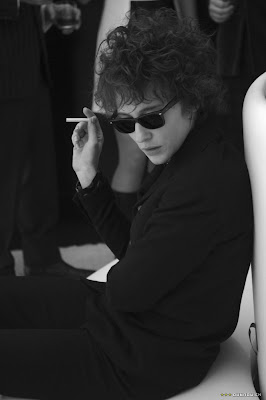
One watches The Birth of a Nation from the present like a cop at a mob funeral: separated from its mournful agonies by an unbridgeable chasm, the fierce emotion at its center something we cannot share. Nearly a century after David Wark Griffith's historical epic emerged as the American cinema's first great lunge toward art, the funny-sad sight of Flora Cameron adding raw cotton appliqués to her burlap dress still carries with it a masterful balance of ruddy gentility and hopeful striving — we can sense it in Mae Marsh's wide, innocent eyes, in her childish belief that the war is just another game of pretend. But we know the image's original sense, for in it we can see the ghost of this country's history of violence. If Flora is innocent, then so is the Confederacy, the nation itself. Such sins are not so easily forgiven, even in the cinema's magical, dreamy dark.
That's not to say that Griffith's film was not as controversial upon its release in 1915 as it is today. Woodrow Wilson famously praised the film after it was screened at the White House, while the NAACP launched protests against it. Melvin B. Tolson called it such a "blatant lie that even a moron could see right through it," while James Agee placed it on par with Lincoln's speeches or Whitman's poetry. Regardless of its artistic merit, it is certainly one of the three or four most important films in the history of American cinema, the flash of lightning from which all our other fires and sparks have descended: its hateful tale of a nation's (re)birth also functions as the birth of a national cinema, the original sin we've spent a century attempting to redeem.
For The Birth of a Nation was that difficult thing, a racist masterpiece, a technical marvel whose history of Reconstruction was so egregious that it changed the trajectory of African-Americans on film. Not until Mario van Peebles did black men regain on-screen strength, relegated in the interim to empty, demeaning minstrelsy (Mr. Bojangles, Step-n-Fetchit) or unthreatening quiet (Sidney Poitier, a fine actor whose misused talents never achieved the reclaiming force of later blaxploitation pictures). Yet by introducing and developing the close-up, cross-cutting and the iris, Griffith took a leading role in the invention of a filmic syntax which remains with us to this day. For better or worse, The Birth of a Nation is cinema's subject, object and verb.
The real question one asks in any reappraisal of the film is perhaps impossible to answer. "Is it art?" Perhaps not, if you are of the mind that historical importance and artful beauty are separate qualities. That is not because The Birth of a Nation tells a tale of misery and woe — Alain Resnais twice found terrible beauty in history's burnt-out path, in the warning sorrow of Night and Fog and the cosmic loneliness, the laborious love, of Hiroshima, mon amour. But Resnais' films attempted to reclaim humanity rather than deny it. On the other hand, the beauty in certain of Griffith's compositions — like the forces curving around the side of a hill on the way to Atlanta, a scythe at the neck of the Confederacy — does not outweigh the militant ugliness of his racism. The film history that commences with The Birth of a Nation is a history not just of form but also of narrative content, a history whose art resides, if only too rarely, in its striving depiction of what a man no less artful than Abraham Lincoln called "the better angels of our nature." Griffith's film is a terrible angel, one to which we are as irrevocably tied as the Civil War or Reconstruction itself. And in that we are culpable all the more for using the syntax it developed to say something more perfect about our tenuous Union.



